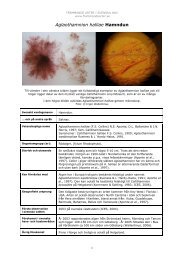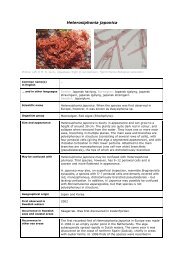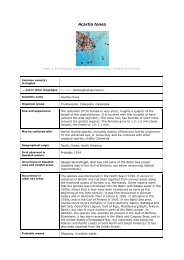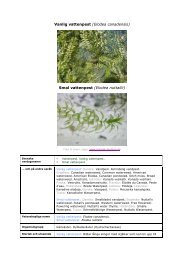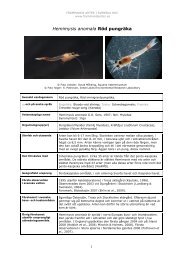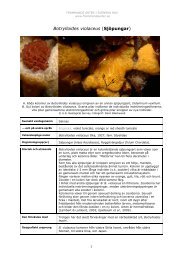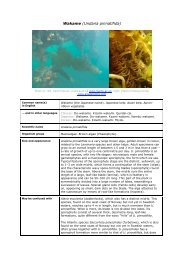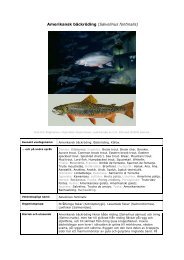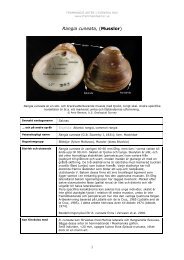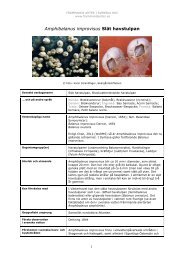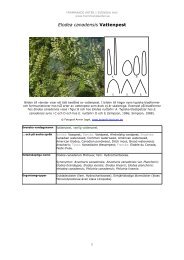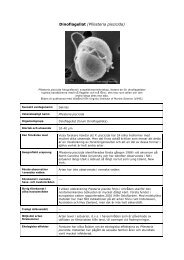Gracilaria vermiculophylla
Gracilaria vermiculophylla
Gracilaria vermiculophylla
You also want an ePaper? Increase the reach of your titles
YUMPU automatically turns print PDFs into web optimized ePapers that Google loves.
<strong>Gracilaria</strong> <strong>vermiculophylla</strong>Photos: Above © Lars-Harry Jenneborg/HydroGIS. Below © Inger WallentinusCommon name(s)in English… and in other languagesScientific nameOrganism groupSize and appearance–Swedish: Grov agaralg. Perukalg.<strong>Gracilaria</strong> <strong>vermiculophylla</strong>. Formerly also known as <strong>Gracilaria</strong> asiatica.Macroalgae. Red algae (Rhodophyta).This alga grows to a length of 15–100 cm, with branches around 2–5mm in diameter. It is irregularly but quite richly branched (resemblesa wig), the branching either profuse or sparse depending on how theplant grows and whether it is unattached (see image to the right on thenext page).Large specimens may be hollow lower down the plant. The colourvaries, from brownish to a greyish wine-red, depending on theavailability of sunlight. Loose-lying specimens often lack epiphyticgrowth. The male reproductive organs are borne in pits (conceptacles)that are usually more than 75 µm deep. It is not unusual for younggermlings to grow as epiphytes on older plants of the same species.© Lars-Harry Jenneborg/
May be confused with<strong>Gracilaria</strong> <strong>vermiculophylla</strong> can sometimes beconfused with brown algae.It may also be mistaken for <strong>Gracilaria</strong>gracilis, a closely related Swedish red alga(see image to the left).The latter, however, is a more distinct redcolour, smaller and more delicate, and moresparingly branched. In G. gracilis, moreover,the male conceptacles are usually less than50 µm deep. G. <strong>vermiculophylla</strong> is alsosimilar to <strong>Gracilaria</strong> longissima, althoughthat species, too, is a more distinct red, andoften has its branches oriented in the samedirection. G. longissima bears its maleorgans on the surface of the thallus.Photo: © Inger Wallentinus.Left: Comparison with G. gracilis.Right: Richly branched G. <strong>vermiculophylla</strong>("the wig").Geographical originFirst observed inSwedish watersOccurrence in Swedishseas and coastal areasOccurrence inother sea areasProbable meansof introductionHabitat(s) in whichspecies occursEcological effectsEast and South-East Asia.2003Along the west coast, from Öckerö in the northern Göteborgarchipelago to central Halland (Bua harbour and Träslövsläge). Onespecimen has been found in Brofjorden (central Bohuslän).The species is found along the west and east coasts of Jutland inDenmark; at Kiel, Germany, in the south-west Baltic and along theNorth Sea coast of Germany; on the coasts of northern Spain,Portugal, France and the Netherlands; and in the coastal waters ofMorocco. It also occurs along the coasts of the United States (NorthCarolina, Virginia and California) and Mexico.Shipping, in ballast water and sediment or as a fouling organism. Maypossibly be dispersed by currents, but large specimens do not float.The species may also spread as a result of fragments becomingentangled with nets, lines and anchors, for example, and subsequentlycoming loose.This species usually occurs in the form of loose-lying plants on mud orfine sand, but may also be attached to rocks or shells. It is mostcommonly found in very shallow inlets, but is also seen in eelgrass(Zostera marina) beds. Individual specimens can be found down todepths of 4–5 m. <strong>Gracilaria</strong> <strong>vermiculophylla</strong> can form tangled mats,but often occurs as single individuals. It is very tolerant, and in thelaboratory can grow in water with as low a salinity as 2 psu(corresponding to conditions in the far north of the Bothnian Bay). Thespecies can survive for more than six months in the dark in only amoist environment (out of water), and then start to grow again. It canreproduce vegetatively and disperse as small fragments (less than 1cm long) in nets and on lines.<strong>Gracilaria</strong> <strong>vermiculophylla</strong> can form dense mats on eelgrass beds,shading the eelgrass and inhibiting its growth. It often grows in thesame locations as the red-listed dwarf eelgrass (Zostera noltii), towhich it probably poses a greater threat than it does to the larger and
more common eelgrass species Zostera marina. On shallow muddysubstrata, loose-lying individuals or mats of G. <strong>vermiculophylla</strong> mayadversely affect the habitats of benthic fauna and microalgae. At thesame time, the species can enrich bare substrata by creating newshelter and habitat for small benthic animals.Other effectsAdditional informationThe species fouls fishing gear, and from North Carolina there arereports of it causing problems for commercial fisheries. It has alsoclogged cooling-water intakes. Large specimens could becomeentangled round the propellers of small boats, but usually the plantslie on the seabed.In Asia <strong>Gracilaria</strong> <strong>vermiculophylla</strong> is cultivated as a raw material forthe production of agar, a jelly-like thickening agent. Among otherthings, agar is used in Petri dishes and test tubes as a culture mediumfor bacteria.FIND OUT MORE• AquAliens: Rödalgen från Asien (Red alga from Asia)http://www.aqualiens.tmbl.gu.se/Gracilinfo.htmlhttp://www.aqualiens.tmbl.gu.se/gracilphot.html• 2 MB: Havforskningsinstituttet: Japansk rødalge i spredning: <strong>Gracilaria</strong> <strong>vermiculophylla</strong>http://www.imr.no/__data/page/4998/Nr_11-Japansk_rdalge_i_spredning_Graciliaria_<strong>vermiculophylla</strong>.pdf• Havforskningsinstituttet: <strong>Gracilaria</strong> <strong>vermiculophylla</strong> - nyintrodusert japansk rødalgehttp://www.kystsone.no/news.cfm?newsitemid=734• FIMR, Östersjöportalen: Aasialainen levä uhkaa Ruotsin länsirannikon kalakantojahttp://www.fimr.fi/fi/itamerikanta/bsds/2340.html• AlgaeBase: <strong>Gracilaria</strong> <strong>vermiculophylla</strong>http://www.algaebase.org/speciesdetail.lasso?species_id=4417• 1,1 MB: Universität Rostock, Meeresbiologie: Die Bedeutung eingeschleppter Arten(alien species) für die Europäische Wasserrahmenrichtlinie am Beispiel der Ostsee.http://www.biologie.uni-rostock.de/oekologie/literature/RMB/RMB-15/RMB-Band-15-Schories-et-al-neozooen-147-158.pdf• Baltic Sea Alien Species Database: <strong>Gracilaria</strong> <strong>vermiculophylla</strong>http://www.ku.lt/nemo/directory_details.php?sp_name=<strong>Gracilaria</strong>+vermicullophylla• Mie University. Lab. Phycology: <strong>Gracilaria</strong> <strong>vermiculophylla</strong>http://soruipc2.bio.mie-u.ac.jp/sourui_photo/rhodo/ogonori.html© Lars-Harry Jenneborg, HydroGIShttp://home.swipnet.se/hydrogis/indexx.htm© Inger Wallentinus, AquAlienshttp://www.aqualiens.tmbl.gu.sePHOTO CREDITS• This factsheet on <strong>Gracilaria</strong> <strong>vermiculophylla</strong> was created on 20 September 2005• First update: 6 August 2006• Second update: 6 November 2006• Translated by Martin Naylor on 1 December 2006• Third update ("Find out more" only): 16 December 2006



